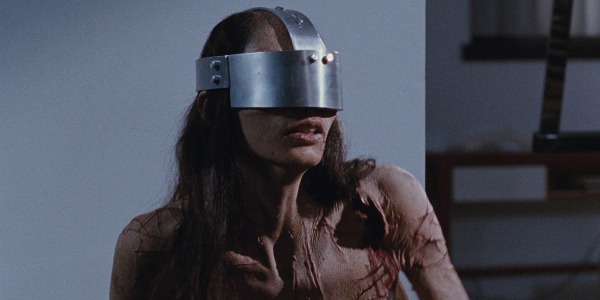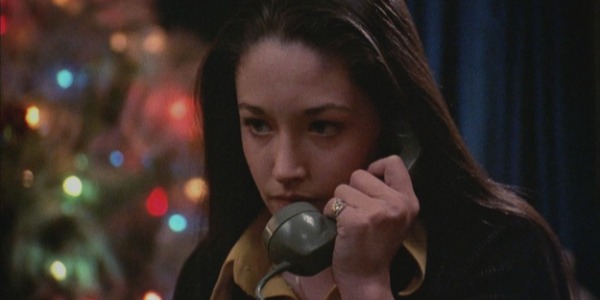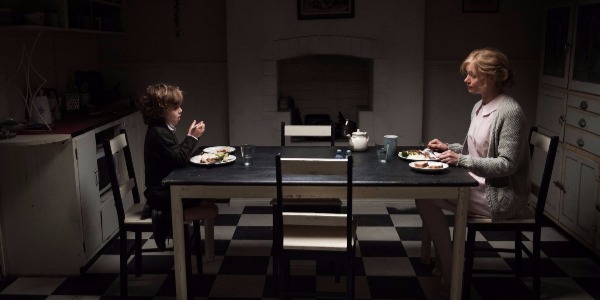Staff Inquiry: Scenes That Scarred Us

Alex is a film addict, TV aficionado, and book lover.…
A boss of mine once chuckled when a co-worker apologized for cursing in front of me, remarking that “you can’t offend her; she watches films.” There’s more truth to that statement than my non-movie watching boss probably realized, as any cinephile has probably seen more nasty, skin-crawling moments than they can count. Sometimes this is in the name of demented fun, but other times these are so intense that they leave a mark.
This month our staff are recalling the latter, dredging up the scenes from TV and film that freaked us out, made us queasy, or we just plain can’t get out of our heads. Be warned that this is basically a list of troubling stuff, but hey, we could all use some group therapy, right?
Andrew Winter – Secret Room in Martyrs (2008)

As a sensitive teenager, the eye scene in Zombie Flesh Eaters gave me sleepless nights. As an adult – long since jaded by decades of watching horror films both gruesome and bizarre – I foolishly thought I was beyond such terrors. Then I saw Martyrs.
Pascal Laugier’s controversial film (rather than the 2015 Hollywood remake) concerns a religious secret society who systematically and methodically tortures young women, believing that their suffering will enable them to transcend this world and glimpse the afterlife. Lucie (Mylène Jampanoï) escapes the society as a young girl, but 15 years later is still haunted by her terrible past and seeks violent revenge against members of the group.
Calling it torture porn would be lazy, mainly because Martyrs is so much better and more disturbing than the pantomimic likes of Hostel or Saw. I greatly admire its ability to make me feel both horribly uncomfortable and indescribably grubby. Watching the film is an endurance test, not just because it is pitiless and nihilistic, but also because Laugier’s appetite for transgression really messes with your head. In other words, it does everything good horror is supposed to.
I could pick half a dozen scenes to discuss, but it’s one in which Lucie’s friend Anna (Morjana Alaoui) discovers another young woman imprisoned in a secret room that really gets to me. The girl is emaciated, covered in cuts and wounds, can barely walk after being chained up, and has a steel visor contraption practically nailed to her head so she can’t see. She looks and sounds barely human. It’s a sequence full of deeply upsetting images that, try as I might, I have never been able to shake from my mind’s eye. The scene perfectly sums up Martyrs’ sense of utter despair.
Jake Tropila – The Eye in Black Christmas

The premise of 1974’s Black Christmas is enough to send shivers down your spine: on the eve of their Christmas vacation, a group of sorority girls are making plans for their own Yuletide getaways. Unbeknownst to them, a deranged maniac has broken into the attic of their house and begins picking the girls off one by one. After each death, the maniac places an obscene phone call to the surviving members of house, threatening that they’ll be next.
What’s terrifying about this premise is that it taps into a very specific fear I have: not being aware there’s a stranger hiding inside your own home. It’s a simple phobia but one that is pulled off with aplomb here. The real hair-raising moment arrives towards the movie’s conclusion: Our final girl, Jess (Olivia Hussey), learns from her local police department that the calls are coming from inside the house and she needs to hightail it out of there. Unsatisfied with the prospect of leaving her friends behind (and unaware that they’re already dead), she heads upstairs to investigate only to discover a pile of corpses and the killer himself, taking on the form of a spastic looking eyeball, staring at Jess from behind a cracked door.
That lone shot of the killer’s eye peeking through the door crack has given me countless nightmares. It’s a moment I regard as one of the scariest in horror movie history. Black Christmas invokes that fear of turning off a light and running out of a darkened room. You know you’re alone, but you want to make damn sure nothing can grab you.
Linsey Satterthwaite – The Beach in Under the Skin (2013)

There are many moments in Jonathan Glazer’s hypnotic sci-fi masterpiece that could disturb the viewer, but the scene that shook me to my core is devastating in its simplistic brutality. It involves a tragic event on a Scottish beach which results in a helpless baby being left abandoned while Scarlett Johansson’s alien continues with her mission, oblivious to the plight of the vulnerable infant. It’s a heartbreakingly visceral image, a child unable to walk or fend for themselves, left completely alone on a wintry beach, exposed and defenceless, its uncontrollable cries going unanswered. We return to the same scene later when night has fallen and the baby remains in the same place, still crying, still utterly alone.
As I write about this, I can feel the hairs on my arms prickle and my skin go cold. My heart wrenches and I am transported straight back to that moment when I saw this for the first time and remember the sheer trauma I felt. Glazer’s scene is almost too shatteringly effective for its own good, as I spent the next 15 minutes unable to concentrate on the film. My mind kept replaying the horror of what I had just seen over and over again.
I’m not a maternal person and have no children of my own, so I can only imagine how much worse this scene would be for people who have kids, the absolute unimaginable distress it could instill in them. It’s something that is now imprinted in my memory, and just the mention of Under the Skin reminds me of that scene, of being a cinematic bystander, immobilised, unable to help and instead forever haunted and scarred by a celluloid nightmare.
Matthew Roe – The Finale in A Serbian Film (2010)

Though I have previously called Srđan Spasojević’s 2010 feature debut A Serbian Film an ultimate “feel bad” film, that description doesn’t do the scars justice. Banned in several countries for its unabashed exploitation of rape, necrophilia, and child abuse, the movie centers on Miloš (Srđan Todorović), an aging porn star who is tricked into performing in a sexual snuff film by the darkly charismatic director Vukmir (Sergej Trifunović).
While the film is ultimately a stag reel of increasingly bizarre and cruel violence, it attempts to sell itself as a cynical parody of the Serbian cultural landscape. Spasojević was quoted saying his film “denounces the fascism of political correctness,” though I personally find this a rather weak cover for a hamstring narrative that invests in minimal subtext; it simply delivers a relentless succession of brutality. Much of this cinematic abomination could justly make this list, however the worst is actually (and subtly) the final scene.
After living in hell the past 100 minutes, Miloš, his wife, and their son lie dead at their own hands, believing that group suicide was actually the only humane way out. A trio of black market filmmakers enter the bedroom, and before we get a hard cut to black, one man says to the other while holding a camera:“start with the little one”; the other unbuckles his pants…
I have seen so many graphic horror and exploitation films that I’m usually desensitized to on-screen violence and sex, but this was something else. This film pushed boundaries a little too far for me to consider their final result redeeming in any way. While remaining an utterly effective shock experiment (giving me healthy braces of nightmares), this remains one of the most revolting and scarring films I’ve seen in my entire life.
Amanda Mazzillo – Swallowing Heroin Condom in The Mule (2014)

Thinking about scenes that scarred me for life has brought me to a fairly recent film instead of one of the horror movies I saw bits of as a kid. The 2014 film The Mule contains a scene which made me so uncomfortable I could barely concentrate, and while I reverted to peering through the fingers covering my eyes, this didn’t help much.
The Mule is directed by Tony Mahony and Angus Sampson and written by Leigh Whannell, Angus Sampson, and Jaime Browne. The scene that affected me so much involves swallowing a condom filled with heroin, which until this moment had been stored in a very different place. The sounds of swallowing in combination with the bag, now stained brown and covered with remnants of shit, being put in an area where it should never is what made this scene so uncomfortable and unforgettable.
Whenever someone asks me which film has made me feel grosser than any other, they’re always surprised it’s a dark comedy and not something gory. It’s known though that people eating things they shouldn’t, be it overly spoiled food or something a little more extreme, has always been one of the elements of film that affects me more than anything else. The Mule manages to capture this discomfort in its images, but it lingers because the sounds push the scene past anything else I’ve seen on the topic. Angus Sampson gave one of the few performances that made me feel like I was going to gag from hearing his character do the same.
Phoebe Lewis – Police Station in The Babadook (2014)

I’m not a blood-and-guts horror fan. What really gets me are the moments where the edges between horror and normalcy blend and the monsters seem to be hiding in plain sight. I find those moments terrifying not just because of the dramatic irony (look, the monster’s behind you!) but also because they play on a situation so easily recognizable from daily life. Most people have had the experience of seeing a shadowy image in the corner of a room but upon further inspection realize it’s just a coat on a chair. The Babadook takes that situation and makes you question your own reason – was it really a coat on a chair or are you just telling yourself that?
In a pivotal scene approximately halfway thorough The Babadook, Amelia (Essie Davis) is frantically trying to protect her family from an onslaught of terrifying encounters with a menacing presence, and in a fit of desperation she runs to a local police station. As she’s speaking with an officer, in the background we see a jacket hung on the wall and a long, black, slender hand slowly emerge from the sleeve. We immediately recognize it as the Babadook, and she does, too. It’s a moment of sheer terror coupled with the realization that she is utterly alone and helpless in her struggle.
There are other scenes in the film that echo the feeling of your eyes tricking you, but to see the Babadook in such a mundane setting – a police office, where dangerous things are meant to be documented and secured – creates a distinct feeling that things have completely slipped out of Amelia’s control. After all, nothing is scarier than not being able to trust your own eyes.
Kevin Lee – The TV in Ringu (1998)

Yes, it’s a cliché pick, but the TV scene from the original Japanese Ringu still haunts me to this day. The idea that a ghost in a cursed tape can somehow approach you and break the boundaries of the TV screen, that Sadako (the antagonist) can easily transition from her virtual world to our physical world just by crawling through is the epitome of terror.
Director Hideo Nakata even paces the scene with an intentional slow burn. Sadako doesn’t jump or run through the TV; it’s just a slow, simple crawl. It looks effortless on the spirit’s part, rendering us even more vulnerable than before. Nakata doesn’t resort to gore or jump scares, either. All you need is some disturbing imagery of Sadako’s nails (or her lack of nails) and some well-placed hair to obscure her face. It’s the perfect balance of seeing something terrifying and imagining something even worse underneath.
But perhaps the thing that really hits this scene home as one of the most frightening in cinema is its context and its place in the film. Unlike most horror movies, whose scariest moments are in its buildup or climax, the TV scene occurs in the last 15 minutes of Ringu, after the climax has supposedly ended. The characters learn about Sadako’s origin and did what was necessary to end her curse. We all thought the nightmare was over and were ready to accept Ringu as a lurid, tragic drama with some supernatural elements. The fact that the film uses the TV scene to signify the nightmare’s not over is the final nail on the coffin. It’s the ultimate curveball a horror movie can throw.
Adriana Gomez-Weston – Cherry Vomiting in The Witches of Eastwick (1987)

There are some scary films out there, but the one that impacted me more than anything was The Witches of Eastwick. It’s not a horror film, but it had some pretty disturbing scenes that left me unsettled.
When I was a child, long before my siblings and I had a TV of our own, I would watch movies with my mom. The first time I ever watched The Witches of Eastwick terrified me, as silly as it may seem. The scene that scarred me forever was the infamous cherry pit vomiting scene. Felicia Alden (Veronica Cartwright) was Eastwick’s resident bible thumper, hellbent on exposing the three witches Sukie, (Michelle Pfeiffer) Jane, (Susan Sarandon) and Alex (Cher) and their unconventional relationship with the Devil himself- Daryl Van Horne (Jack Nicholson). To punish Felicia, the witches cast a spell on her, causing her to spontaneously projectile vomit cherry pits everywhere.
As someone who can’t stomach the sight or sound of when other people are sick, this scene was blood curdling. At the time, the scene was just a little too real, and I tried to hide, covering my eyes and ears. When doing some research into the film, it was revealed that the scene was supposed to be even more gruesome, with a flailing animatronic puppet of Cartwright that spewed all over the place. Fortunately (for me at least), the puppet was too vile for test audiences. While The Witches of Eastwick is actually a pretty good movie with a feminist message, I still avoid watching it to this day because of that one scene. Cherries are ruined for me forever now. “Have another cherry.” Ummm…No thank you.
Zoe Crombie – Weeping Angels in Doctor Who (1963-)

Since first watching it on an old TV in a cold hotel with my older cousin and his friends, I’ve thought of Blink as one of the defining moments in my media consumption. Everything else that had frightened me up until that point contained some kind of body horror; the face melting in Raiders Of The Lost Ark for instance. The Weeping Angels of this episode have no such features – in fact, they just look like regular, if slightly creepy, statues. With this rather subdued character design, what the show managed to pull off with its scares was fascinating in retrospect but horrifying to my eight year old self who reluctantly witnessed it back in 2007.
Beginning for me when our two protagonists mutter in horror ‘You’re not looking at the statue’, ‘neither are you…’, the sound design and editing is what makes the scene for me. The occasional jump scare stock sound is used to punctuate sudden movements, but it’s the buildup of tension as the leads force themselves not to blink that brought me the most discomfort. Synths rising agonisingly slowly in pitch are juxtaposed with creaking noises that may or may not be diegetic, and this all lends an unbearable sense of dread to the nightmare creatures. When paired with long, slow zooms on the wide-eyed faces of our heroes that are cut short by sudden close ups on a snarling angel’s face, it creates an atmosphere of imminent doom.
The stakes are perhaps at their lowest in this episode of Doctor Who: rather than the fate of the universe or our main cast of characters being at risk, we focus in on a pair who haven’t appeared before and never do again. This is a testament to how well made this episode is – you care about characters you hardly know – but it may also be the core reason why it works. An average viewer is not the Doctor nor a fearless companion. What they are, though, is an observer, unaware of the majority of the bizarre events always occurring around us. They’re alone, clueless, and being hunted down in their daily lives. Blink brought the fear home and gave me recurring nightmares for years after.
Those are some of the scenes that scarred us. What are some of yours?
Does content like this matter to you?
Become a Member and support film journalism. Unlock access to all of Film Inquiry`s great articles. Join a community of like-minded readers who are passionate about cinema - get access to our private members Network, give back to independent filmmakers, and more.
Alex is a film addict, TV aficionado, and book lover. He's perfecting his cat dad energy.













